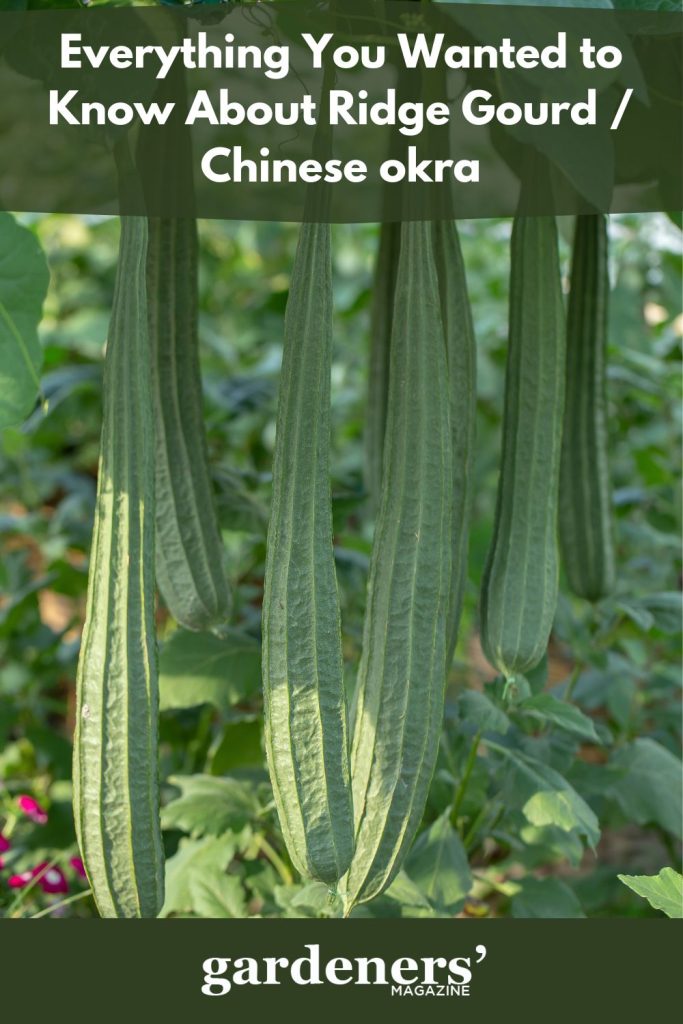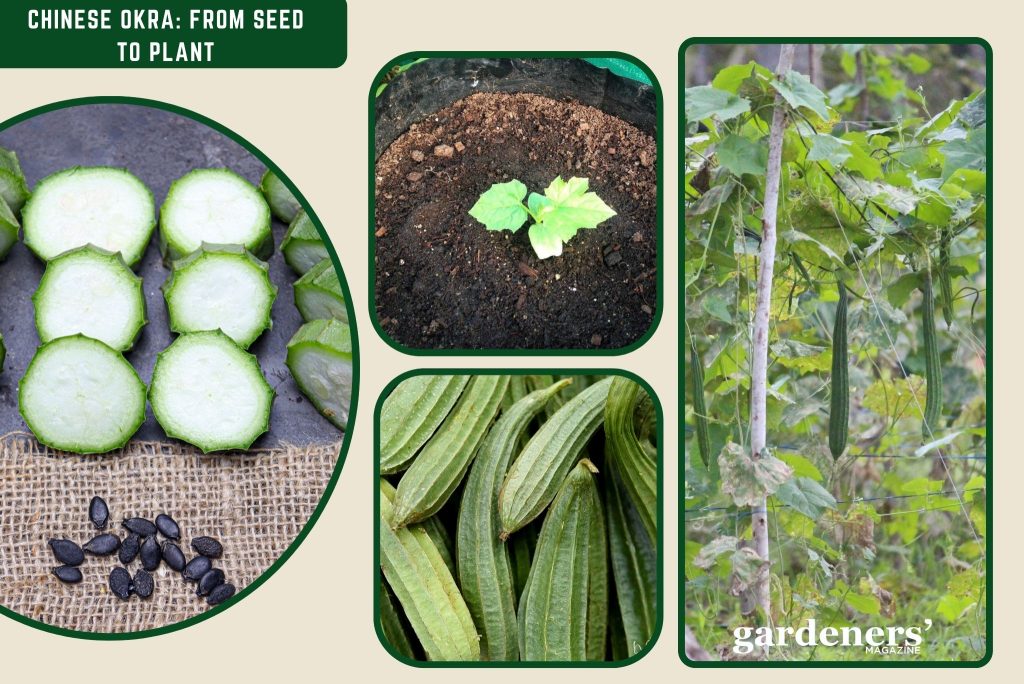Chinese okra, or Luffa acutangula, isn’t just another vegetable in the garden; it’s a globe-trotter, making appearances in kitchens far and wide. This unique gourd, with its ridged skin and elongated shape, brings a mild, slightly sweet flavor to dishes, making it a beloved ingredient in everything from stir-fries to soups. Its versatility shines in various cuisines, especially in Asian countries where it’s a staple.
Beyond its taste, Chinese okra holds a special place in cultural traditions, often featured in festive meals and everyday dishes alike. Growing it is a joy, as it eagerly climbs and sprawls, promising a bounty of gourds. It’s a plant that connects gardeners and cooks to traditions and flavors across the globe.
The Many Names of Chinese Okra
In the world of gardening and cooking, Chinese okra goes by many names, a testament to its global popularity. Known scientifically as Luffa acutangula, this versatile vegetable is called “Turai” in Hindi, a name that resonates in many Indian kitchens. In English, we stick to “Chinese okra,” while in the Philippines, it’s fondly referred to as “Patola.”

Our friends in Thailand know it as “Thai Okra.” Each name reflects the unique cultural backdrop and culinary traditions where this vegetable plays a starring role. Whether you’re in a bustling market in Mumbai, a cozy kitchen in Manila, or exploring a vibrant street food scene in Bangkok, the mention of these names will likely bring up images of delicious, home-cooked meals featuring this beloved gourd. It’s a plant that not only crosses borders but also connects diverse culinary worlds.
History and Origin
Ridge Gourd is one of the oldest vegetables to be cultivated in India, with evidence suggesting that it has been used for centuries. It is believed to have originated from Southeast Asia and spread to other regions due to its popularity as a medicinal plant. Ridge Gourd was so popular at the time that it was even mentioned in ancient Indian texts such as the Charaka Samhita, an ancient Ayurvedic text.

Description
Ridge Gourd is a light green cucumber-shaped vegetable with ridges running lengthwise along its skin. Its skin is tough and waxy, making it difficult to cut through. It has white flesh that can range from crunchy to soft, depending on its maturity. Its flavor is slightly bitter and sour, making it a great addition to curries and other dishes for added flavor.
Flavor Profile
Ridge Gourd has a unique flavor profile that is both sweet and sour with slight bitterness. Its crunchy texture makes it a great addition to salads, soups, and other dishes. It can also be cooked into a curry with other vegetables for added flavor and texture.
Nutritional Profile and Health Benefits
Diving into the world of Chinese okra reveals a nutritional treasure trove. This humble gourd is packed with goodness, making it a fantastic addition to any meal for those mindful of their health. Rich in dietary fiber, it’s a champion for digestion, helping to keep things moving smoothly. But that’s just the start. Chinese okra is also loaded with vitamin C, a crucial antioxidant that boosts the immune system and keeps your skin radiant. Let’s not forget the vitamins A and B, along with minerals like calcium, magnesium, and iron, all contributing to bone health, energy levels, and overall well-being.
Regularly adding Chinese okra to your diet can have impressive benefits. It’s known to aid in weight management, thanks to its low-calorie content and high water volume. Plus, its nutrient-rich profile supports heart health and can help regulate blood sugar levels. So, whether you’re tossing it into a stir-fry or blending it into a soup, you’re not just adding flavor—you’re boosting your meal’s nutritional value.
Growing Chinese Okra
- Getting Started: First things first, Chinese okra loves the sun. I make sure to plant it in a spot that gets plenty of light. It’s not too fussy about soil, but well-draining soil works best. I mix in some compost to give it a good start.
- Soil and Climate: It thrives in warm climates, so I wait until the danger of frost has passed before planting outdoors. In cooler zones, starting seeds indoors about 4-6 weeks before the last frost date gives them a head start.
- Planting in Different Zones: Across the US, timing is everything. In warmer zones (9-11), I plant directly in the ground in spring. In zones 6-8, I protect the young plants with mulch or a cover on chilly nights.
- Care Tips: Regular watering keeps it happy, especially during dry spells. However, I’m careful not to overwater. A little fertilizer goes a long way, and I keep an eye out for pests, picking them off if they dare to visit.
- Harvesting: Ridge Gourd should be harvested when its skin turns a light green color and its flesh is still firm. It can then be stored at room temperature for up to two weeks.
Comparison with Other Vegetables
Chinese Okra vs. Gourd: At first glance, Chinese okra and regular gourds might seem similar with their green skins and elongated shapes. But, in my garden, Chinese okra stands out for its ridged texture and slightly sweeter taste. While gourds are often used for decoration, Chinese okra is a staple in my cooking, bringing a unique flavor and texture to dishes.
Chinese Okra vs. Luffa: Now, this is where it gets interesting. Many folks confuse Chinese okra with luffa because, well, they’re relatives. But while luffa is often grown for its fibrous interior (hello, natural sponges!), Chinese okra is all about the edible flesh. I find Chinese okra to be more tender and versatile in the kitchen, especially in stir-fries and soups.
In my little green world, each vegetable has its place, but Chinese okra holds a special spot. Its unique characteristics make it a delightful addition to my garden and my plate.
Culinary Journey with Chinese Okra
- Diverse Recipes: I’ve found Chinese okra to be a real game-changer in my kitchen. It’s so adaptable! I’ve thrown it into stir-fries for a bit of crunch and even blended it into soups for a silky texture. One of my go-to recipes is a simple sauté with garlic and a splash of soy sauce.
- Indian Delights: Venturing into Indian cooking, Chinese okra really shines. I’ve tried it in a tangy “Turai Masala,” where its subtle sweetness pairs beautifully with spices. Another favorite is “Turai Moong Dal,” a comforting lentil dish that’s both nutritious and filling.
- Eating Tips: Getting Chinese okra ready is easy. I usually give it a good wash and peel off the ridges if they’re too pronounced. Cutting it into pieces, I either cook it until it’s tender for soups or keep it slightly crunchy for salads. Honestly, experimenting with Chinese okra has opened up so many delicious possibilities, from savory curries to refreshing salads. It’s a veggie that never gets boring.
Frequently Asked Questions
Is Chinese okra the same as Turai or Patola?
Yes, Chinese okra is indeed the same as Turai and is also known as Patola in some regions. These are just different names for the same vegetable, depending on where you are in the world. In my garden, I call it Chinese okra, but when I chat with friends from India or the Philippines, we might say Turai or Patola. It’s all the same versatile and tasty gourd.
Can you eat Chinese okra raw or cooked?
While Chinese okra is most commonly eaten cooked, which brings out its tender texture and sweet flavor, it can be eaten raw when it’s young and tender. Cooking it, though, is my preferred method, as it allows the vegetable to absorb the flavors of the dish, enhancing its natural taste. Whether stir-fried, steamed, or added to soups, Chinese okra is a delightful addition to a variety of dishes.
- Everything You Wanted to Know About Red Tamarillos - June 2, 2025
- A Guide to Tulips: Everything You Need to Know & More… - June 2, 2025
- Guanabana: Description, Flavor, Benefits, And Uses - May 27, 2025

1 thought on “Everything You Wanted To Know About Ridge Gourd / Chinese Okra”
Comments are closed.